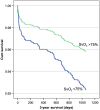Central venous oxygen saturation during cardiopulmonary bypass predicts 3-year survival
- PMID: 23065747
- PMCID: PMC3523619
- DOI: 10.1093/icvts/ivs363
Central venous oxygen saturation during cardiopulmonary bypass predicts 3-year survival
Abstract
Objectives: Long-term survival after cardiac surgery is determined by a number of different risk factors. Central venous oxygen saturation (S(v)O(2)) measures the balance between oxygen delivery and demand. S(v)O(2) levels in the intensive care situation are reported to be associated with patient outcome. The present report explores the connection between S(v)O(2) during cardiopulmonary bypass (CPB) and survival after cardiac surgery.
Methods: Retrospective analysis of one thousand consecutive cardiac surgical patients was undertaken. S(v)O(2) during CPB was monitored online. Registry data combining specific risk factors with S(v)O(2) were selected for Kaplan-Meier and Cox regression analysis to examine the influence on 30-day and 3-year survivals.
Results: Nine-hundred and thirty-two patient records were eligible for analysis. S(v)O(2) below 75% during CPB was associated with significantly shorter 30-day and 3-year survivals. Based on Kaplan-Meier statistics, the survival rate decreased by 3.1% (98.1-95.0), P = 0.011 and 6.1% (92.7-86.6), P = 0.003, respectively. The influence of S(v)O(2) on 3-year survival remained statistically significant after controlling for a series of risk factors in the Cox regression analysis. Patients with S(v)O(2) <75% carried a 2-fold (odds ratio 2.1) increased relative risk of shortened 3-year survival (P = 0.003). Other risk factors statistically significantly associated with 3-year survival were age, gender, duration of CPB, blood temperature, hypertension, haematocrit and type of surgical procedure.
Conclusions: We report decreased 30-day and 3-year survival expectancy for patients experiencing S(v)O(2) lower than 75% during CPB.
Figures


Similar articles
-
Continuous Metabolic Monitoring in Infant Cardiac Surgery: Toward an Individualized Cardiopulmonary Bypass Strategy.Artif Organs. 2016 Jan;40(1):65-72. doi: 10.1111/aor.12609. Epub 2015 Nov 19. Artif Organs. 2016. PMID: 26582421
-
Normothermic cardiopulmonary bypass increases cerebral tissue oxygenation during combined valve surgery: a single-centre, randomized trial.Interact Cardiovasc Thorac Surg. 2013 May;16(5):595-601. doi: 10.1093/icvts/ivt016. Epub 2013 Feb 13. Interact Cardiovasc Thorac Surg. 2013. PMID: 23407696 Free PMC article. Clinical Trial.
-
Cardiopulmonary bypass and intra-aortic balloon pump use is associated with higher short and long term mortality after transcatheter aortic valve replacement: a PARTNER trial substudy.Catheter Cardiovasc Interv. 2015 Aug;86(2):316-22. doi: 10.1002/ccd.25776. Epub 2015 Feb 3. Catheter Cardiovasc Interv. 2015. PMID: 25546704 Clinical Trial.
-
Intraoperative Goal-Directed Perfusion in Cardiac Surgery with Cardiopulmonary Bypass: The Roles of Delivery Oxygen Index and Cardiac Index.Ann Thorac Cardiovasc Surg. 2024;30(1):23-00189. doi: 10.5761/atcs.ra.23-00188. Ann Thorac Cardiovasc Surg. 2024. PMID: 38684395 Free PMC article.
-
Do patients with haematological malignancy who need cardiopulmonary bypass have a short-term higher mortality or a higher chance of disease progression?Interact Cardiovasc Thorac Surg. 2014 Sep;19(3):474-8. doi: 10.1093/icvts/ivu190. Epub 2014 Jun 11. Interact Cardiovasc Thorac Surg. 2014. PMID: 24920761 Review.
Cited by
-
Mastering the Best Practices: A Comprehensive Look at the European Guidelines for Cardiopulmonary Bypass in Adult Cardiac Surgery.J Cardiovasc Dev Dis. 2023 Jul 12;10(7):296. doi: 10.3390/jcdd10070296. J Cardiovasc Dev Dis. 2023. PMID: 37504552 Free PMC article. Review.
-
2019 EACTS/EACTA/EBCP guidelines on cardiopulmonary bypass in adult cardiac surgery.Interact Cardiovasc Thorac Surg. 2020 Feb 1;30(2):161-202. doi: 10.1093/icvts/ivz251. Interact Cardiovasc Thorac Surg. 2020. PMID: 31576402 Free PMC article. No abstract available.
-
2024 EACTS/EACTAIC/EBCP Guidelines on cardiopulmonary bypass in adult cardiac surgery.Br J Anaesth. 2025 Apr;134(4):917-1008. doi: 10.1016/j.bja.2025.01.015. Epub 2025 Feb 14. Br J Anaesth. 2025. PMID: 39955230 Free PMC article.
-
Perfusion practices and safety standards in Pakistan: Insights from a preliminary nationwide survey.J Extra Corpor Technol. 2025 Jun;57(2):82-88. doi: 10.1051/ject/2025007. Epub 2025 Jun 16. J Extra Corpor Technol. 2025. PMID: 40523135 Free PMC article.
-
The Inadequate Oxygen Delivery Index and Its Correlation with Venous Saturation in the Pediatric Cardiac Intensive Care Unit.Pediatr Cardiol. 2025 Jan;46(1):39-45. doi: 10.1007/s00246-023-03302-x. Epub 2023 Sep 24. Pediatr Cardiol. 2025. PMID: 37743384
References
-
- Reinhart K, Bloos F. The value of venous oximetry. Curr Opin Crit Care. 2005;11:259–63. - PubMed
-
- Shepherd SJ, Pearse RM. Role of central and mixed venous oxygen saturation measurement in perioperative care. Anesthesiology. 2009;111:649–56. - PubMed
-
- Herbertson MJ, Werner HA, Russell JA, Iversen K, Walley KR. Myocardial oxygen extraction ratio is decreased during endotoxemia in pigs. J Appl Physiol. 1995;79:479–86. - PubMed
-
- Levine E, Rosen A, Sehgal L, Gould S, Sehgal H, Moss G. Physiologic effects of acute anemia: implications for a reduced transfusion trigger. Transfusion (Paris) 1990;30:11–4. - PubMed
-
- Holm J, Håkanson RE, Vánky F, Svedjeholm R. Mixed venous oxygen saturation is a prognostic marker after surgery for aortic stenosis. Acta Anaesthesiol Scand. 2010;54:589–95. - PubMed
MeSH terms
Substances
LinkOut - more resources
Full Text Sources
Medical

